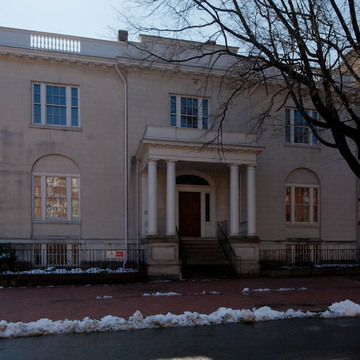A three-way collaboration produced this exceptional neoclassical house, one of three houses that make up the Valentine Museum complex. The designer, a young builder from New England named Alexander Parris, traveled through the mid-Atlantic region in search of architectural education and experience. John Wickham, a wealthy and sophisticated Richmond attorney who wished to display his taste and fortune, hired him to design a new mansion in Court End. During the design process Wickham sent a draft of Parris's plans to his acquaintance, the architect Benjamin Henry Latrobe, whose advice was incorporated into the final scheme. Parris also designed the Executive Mansion (RI3) and at least one other house during his stay in Richmond. He returned in 1812 to Massachusetts, where he established himself as a leading architect.
Parris eventually provided Wickham with this restrained, three-bay design, with a small entrance porch and a circular central stair hall. The three rear rooms offer egress through triple-hung windows onto a single-story portico that overlooks the garden. The central bay of the rear of the house bows out, enlivening the flow between the interior and the exterior. Wickham owned the entire block, and his correspondence indicates that he gardened enthusiastically. Elements from this house and others influenced by Latrobe reappeared in Richmond for several decades. After architectural investigations by Charles Phillips and Paul Buchanan, the high-style building was recently restored and appropriately furnished. Of special interest are neoclassical wall paintings in the parlor and the dining room.
The Wickham House and an eclectic collection of artifacts were willed to the city in 1892 by a later resident, Mann S. Valentine II. The studio of Valentine's brother, the sculptor Edward Virginius Valentine, was moved from a nearby site to the garden in the 1930s, and its
In addition to the Wickham House, the Valentine Museum includes the Italianate Granville Valentine House (1869; 1978, rear addition, Glave, Newman, Anderson) and the Greek Revival Bransford-Cecil House (1840; moved to site in 1954). The museum has exhibitions, a library, and archives devoted to the history of Richmond.






